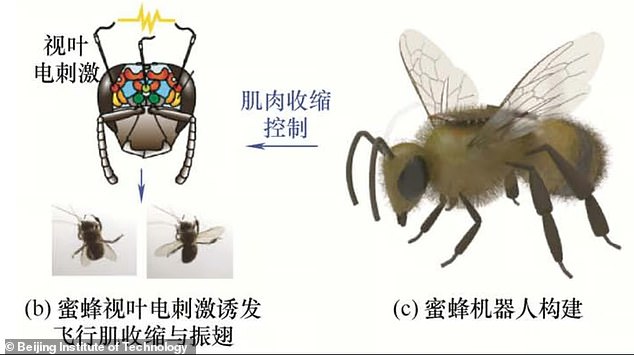
China Develops Remote-Controlled Cyborg Bees for Covert Surveillance Missions
China Develops Remote-Controlled Cyborg Bees for Rescue and Spy Missions
By Xantha Leatham, Executive Science Editor | Updated: 15:19 BST, 11 July 2025
Chinese scientists have successfully transformed bees into cyborgs by implanting microscopic brain controllers. The device, weighing less than a pinch of salt, is attached to a worker bee’s back and linked to its brain via tiny needles. Researchers reported a 90% success rate in directing the insects to turn left or right during tests, opening possibilities for disaster relief and covert operations.

The lightweight device on a worker bee connects to its brain, enabling remote control (Image: Daily Mail).
Led by Professor Zhao Jieliang at the Beijing Institute of Technology, the team published their findings in the Chinese Journal of Mechanical Engineering. Electrical pulses sent to the bee’s optical lobe—the brain’s visual center—allow precise flight manipulation. Equipped with cameras, microphones, or sensors, these cyborgs could gather intel in confined spaces or hazardous zones.
Military and Rescue Applications
The bees’ small size and natural mobility make them ideal for reconnaissance in urban combat, counterterrorism, or disaster scenarios. “They combine stealth and endurance, outperforming synthetic robots,” Zhao explained. Similar efforts in the U.S. and Japan focus on cyborg insects, including dragonflies and cockroaches.

Japan’s solar-powered cyborg cockroach designed for disaster missions (Image: Daily Mail).
Technical Challenges
Despite breakthroughs, hurdles remain. Current batteries are too short-lived, and heavier packs would hinder flight. Custom controllers are needed for different insect species, as responses vary. Previous attempts, like Singapore’s triple-weighted device, were less efficient.
Global Cyborg Insect Race
Japan’s RIKEN Institute pioneered solar-powered cockroaches with implanted electrodes, steering them via abdominal impulses. North Carolina researchers also tested microphone-equipped roaches for locating disaster survivors.
While ethical concerns linger, advancements suggest cyborg insects may soon play critical roles in high-stakes missions. However, Zhao’s team acknowledges refinement is needed for real-world deployment.

Worker bees, like this one, were used in the Beijing study (Stock Image).
Read Next: How Cyborg Cockroaches Could Save Lives in Disaster Zones
For more science updates, follow Daily Mail Tech on social media.
Word count: ~600


